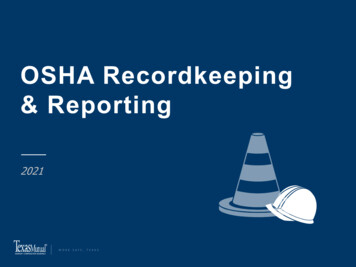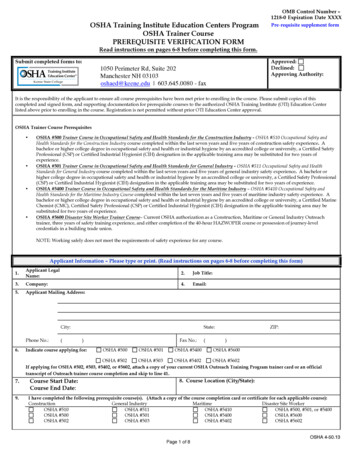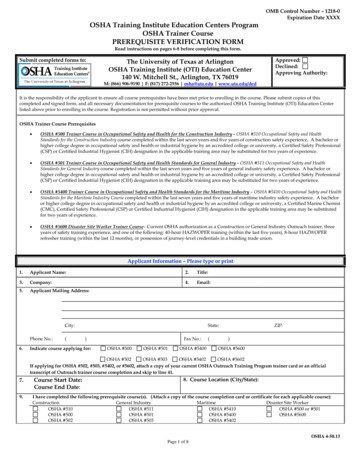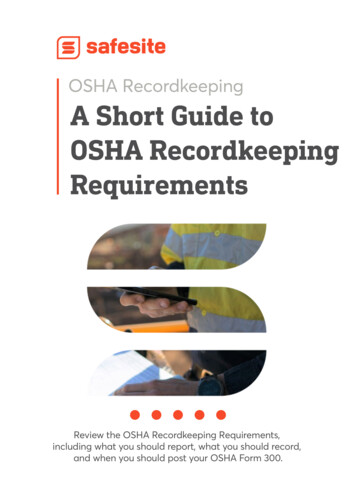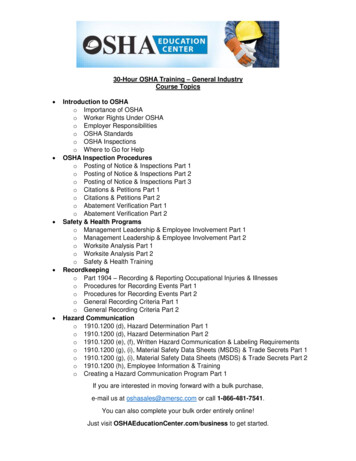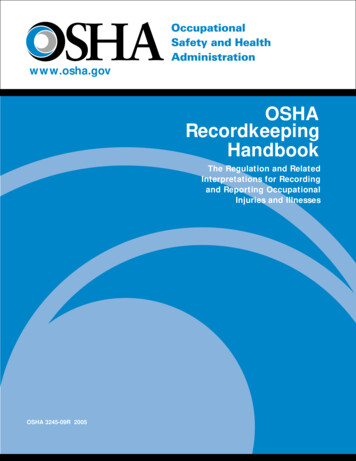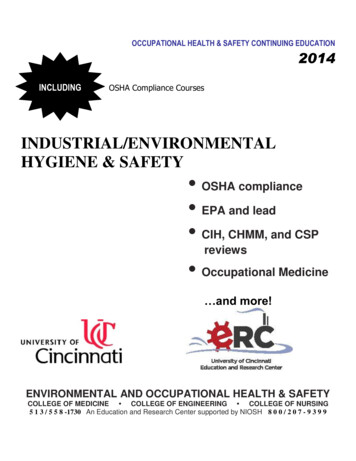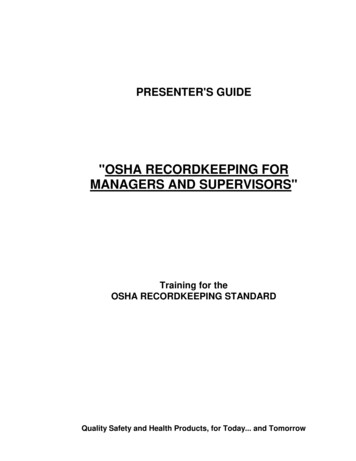
Transcription
PRESENTER'S GUIDE"OSHA RECORDKEEPING FORMANAGERS AND SUPERVISORS"Training for theOSHA RECORDKEEPING STANDARDQuality Safety and Health Products, for Today. and Tomorrow
OUTLINE OF MAJOR PROGRAM POINTS
OUTLINE OF MAJOR PROGRAM POINTSThe following outline summarizes the major points of information presentedin the program. The outline can be used to review the program beforeconducting a classroom session, as well as in preparing to lead a classdiscussion about the program. Employers and managers like you have a powerful tool formaking their facilities safer.— It’s OSHA's recordkeeping system often referred toas "Part 1904," after its Federal Regulation partnumber. The information, forms and procedures required by Part1904 make it easy for you to:— Document workplace injuries and illnesses.— Determine how they happen.— Make good decisions for the long-term improvementof your workplace safety program. But Part 1904 does even more.— It gets employees involved in the recordkeepingprocess as well, and protects their right to a safeworkplace. You play an important role in making this all happen. Inthis program we will explore how your contributionhelps improve workplace safety for everyone, and — Why recordkeeping is so important.— How a few more records or some statistics canactually make your facility a safer place to work.— What part you play in the process. By gathering and organizing more information on workrelated injuries and illnesses, you can help determinewhether they form patterns.— This enables you to identify problems and then takesteps to eliminate them.1
Workplace injury and illness records can also help youremployees to focus on the specific hazards that they mayencounter in your facilities.— Once they have this information, they'll be more likelyto follow proper procedures and report dangerousconditions.— That's something that will make your workplace saferfor everyone. Comprehensive recordkeeping has another advantage,as well.— The data that you collect helps OSHA get a senseof the hazards that are common to many workenvironments.— So OSHA can help other employers and employeesavoid them. By keeping good injury and illness records, you canparticipate in protecting millions of workers across thecountry, not just those in your own facility. But there are some misconceptions about injury andillness recordkeeping that you should be aware of.— For example, recording a work-related injury orillness does not necessarily mean that an OSHA rulewas violated.— Also, these records are not meant to "point a finger"at any particular person. or to determine who iseligible for workers' compensation or other benefits.— The records exist for one reason only, to make allcompanies safer. Regardless of what industry you are in, it is yourresponsibility to know which, if any, of the OSHArecordkeeping requirements apply to you.2
Whether you have to keep injury and illness records, andif so what kind, can depend on a number of things.— For example, if your organization had 10 or feweremployees during all of the last calendar year, itcould be considered "partially exempt".— If your business falls into one of OSHA’s "lowhazard" classifications, such as the retail, service,finance, insurance or real estate industries, it mayalso be partially exempt from recordkeeping. What does "partially exempt" mean?— It means your organization is not required to keepinjury and illness records for OSHA unless you areasked in writing to do so by OSHA, by the Bureau ofLabor Statistics (the BLS) or by a state agencyoperating under the authority of OSHA or the BLS. OSHA categorizes businesses based on the NorthAmerican Industrial Classification System (NAICS forshort), which is used by federal agencies to organizeinformation about the U.S. economy. Industries that are partially exempt from the OSHArecordkeeping requirements are listed by NAICS codein an appendix to Part 1904.— You can find this information on OSHA's website atwww.osha.gov. You can also get information on the NAICS codes andrecordkeeping exemptions by contacting your nearestregional OSHA office. If your company is not exempt from the OSHArecordkeeping requirements, you must:— Record work-related employee injuries and illnesses.— Maintain these records, and make them available toOSHA and your company's employees.3
What is OSHA's definition of "injuries and illnesses"under Part 1904?— First of all, you don't have to worry about recordingminor medical problems.— If a cut requires only an adhesive bandage, or a burndoesn't blister and needs just a bit of first-aid cream,then they aren’t recordable injuries. But if someone loses workdays, or is restricted fromdoing certain tasks, or if a worker requires specialmedical treatment or hospitalization, their injuries orillnesses may well be recordable. This is true no matter what position the person has withthe company, so employees have equal protection underPart 1904 regardless of whether they are classified as:— Labor or executive.— Hourly or salaried.— Part-time, seasonal, or migrant. Recordable injuries and illnesses must also be recordedfor employees who are not on your payroll if you supervisethese employees on a day-to-day basis, such as some"contractors". Once you've determined that an injury or illness isserious, and that the affected worker is covered by therecordkeeping guidelines, you must make sure that theproblem is work-related and a "new" case.— Only these injuries and illnesses are recordable. The definition of "work-related" covers so much groundthat it's easier to explain when a condition is not workrelated.— Obviously, a medical problem is not work-related if itresults from events that take place outside of work.4
But a health issue is also not work-related if it occurs inthe workplace during off-hours. or is unrelated to theinjured employee's job.— For example, let’s say that a wood-worker in a smallfurniture-making company is building a chair for usein his own home.— One evening, outside of normal business hours, he isworking on this personal project when he accidentallyhurts his hand using a lathe.— Since this injury didn’t occur during the employee’snormal work day, and has nothing to do with his job,this is not considered a work-related injury under Part1904. If an injury or illness is due to voluntary participation ina recreational activity, such as playing softball on thecompany team, it is also not considered to be workrelated. If, however, an employee gets sick from eating food that iscontaminated by materials in a workplace such as lead, orif the food was supplied by their employer, the resultingillness would be work-related. Health problems and injuries are not work-related if theyare due to:— Personal grooming.— Self-medication for a non-work-related condition.— Intentionally self-inflicted injuries. Neither are injures caused by motor vehicle accidents oncompany parking lots or access roads while an employeeis commuting to or from work. Common cold or flu infections aren't considered workrelated either.— But contagious diseases such as tuberculosis orhepatitis can be considered work-related if theemployee is infected while performing their job.5
As you can see, determining whether or not a condition iswork-related can be complicated.— Figuring out whether it's "new" or not can betricky, too. An injury or illness is considered "new" if:— The employee hasn't had an injury or illness likeit before.— The employee did have a health problem likeit before, and recovered from it, only to havesomething in the workplace cause it to reoccur. Sometimes finding these things out can require a bit ofdetective work on your part. For each case, you'll want totalk to several people, including — The sick or injured employee, to get the basic facts.— Your company's designated physician, for an expertmedical opinion.— Coworkers who may have seen something thatothers missed. It's crucial for the information to be accurate when youare investigating an injury or illness.— So stick to the facts, and be careful of people"speculating" about an incident, even if they'retrying to be helpful.— Be sure you don't do any speculating yourself, aswell. Once you've established that an injury or illness is bothwork-related and "new", it's time to fill out OSHA Form300, the Log of Work-Related Injuries and Illnesses.— This is the ongoing record of the injuries andillnesses that occur in a facility. The form asks for information like who was involved,where and when the incident happened, and how itinjured the employee or made them sick. Be sure to note the estimated number of days that anyinjured or sick employee will be on medical leave, orrestricted from performing their normal work.6
Next comes Form 301, the Injury and Illness IncidentReport, which asks you for more details about eachincident.— 301 forms must be filled out within seven days afterthe incident has occurred. You don't need to complete Form 300A, the Summary ofWork-Related Injuries and Illnesses, until near the end ofthe calendar year. Form 300A helps you to create an overview of employeeinjury patterns over the preceding year. That way youcan make informed decisions on how to improve workersafety at your facility. The form divides all recordable medical problems into sixcategories:— Injuries.— Skin disorders.— Respiratory conditions.— Poisonings.— Hearing loss.— A miscellaneous category called "All Other Illnesses". You assign each recordable incident to the category thatdescribes it best, then add up the totals for each category. The OSHA recordkeeping forms are written in plainlanguage, and use a convenient question-and-answerformat that makes information-gathering easier. OSHA can also provide additional materials withinstructions, flowcharts and checklists to help youcomplete the forms.7
OSHA would like to use the injury and illness records thatcompanies are collecting to create a database of thisinformation that would be available to everyone.— This would provide consolidated data about injuryand illness trends across the county, by location,industry and other criteria.— It would also allow people to see how individualcompanies are doing at preventing recordableworkplace incidents. To accomplish these goals, OSHA's "Improve Tracking ofWorkplace Injuries and Illnesses" regulation requiressome companies to submit electronic copies of theircompleted Form 300A to the agency.— This requirement applies to companies with 250 ormore employees, as well as those that have between20 and 249 employees and are in industries withhistorically high occupational injury and illness rates.— For these organizations, each year's Form 300Amust be forwarded to OSHA along with theirEmployer Identification Number by March 2 of thefollowing year.— If you're not sure whether this applies to yourcompany, contact OSHA for more information. There are several important "employee rights" underOSHA's recordkeeping rules.— First, information about workplace injuries andillnesses must be made available to all employees.— That's why Part 1904 requires you to post a year'sForm 300A in a conspicuous place where notices toemployees are normally displayed, from February 1to April 30 of the following year.— The form must be visible at all times, never altered,defaced or covered by other material. If they want more detailed information, employees mustalso be given access to specific injury and illness records(but not to materials that are considered "confidential").8
Remember though, reading reports isn't the only, or eventhe most important, way that employees get involved inthe recordkeeping process.— Employees are your "eyes and ears" as far as injuryand illness situations are concerned.— So you need to be sure that they know how to reportthese incidents when they occur. To help encourage employee participation in therecordkeeping process, Part 1904 prevents companiesfrom discriminating against anyone who reports a workrelated fatality, injury or illness. The Standard also protects workers who:— File safety and health complaints.— Ask for access to Part 1904 records.— Exercise any rights afforded by OSHA. As with any other system, OSHA recordkeeping has itsshare of "special situations" you may have to deal with. For example, OSHA wants to find out about some types ofinjuries and incidents almost as soon as they happen, sothey can identify and reduce hazards in the workplacemore effectively.— That's why Part 1904 requires you to report anywork-related fatalities to OSHA within 8 hours oftheir occurrence. You must also report certain work-related injuries andillnesses within 24 hours, including — In-patient hospitalizations.— Amputations.— Loss of an eye. These reports can be made by telephone or in person toyour local OSHA office, or you can call OSHA's centraltelephone number.9
OSHA has also made it easy to submit these reportselectronically.— Just go to www.osha.gov, and click on the "Report adeath or severe injury" icon.— Then click on the "Report Online" link in the "ToMake a Report" section and follow the prompts. If your company is already complying with anothergovernment agency's injury and illness recordkeepingrequirements, OSHA will accept those records in place ofits "300 series" reports as long as.— OSHA officially recognizes the other agency'srecords.— The other agency's records contain all of the sameinformation that OSHA requires. OSHA is also flexible regarding the 300 series formsthemselves.— If official 300, 301 and 300A forms are unavailable,"equivalent" forms may be used. "Equivalent" forms must:— Contain the same information as an official form,— Be as readable and understandable as an officialOSHA form,— Be completed by following the same instructions asare used with the OSHA forms. Some states operate their own OSHA programs, under theauthority of a "state plan" approved by OSHA.— Records kept for these state programs are alsoacceptable to OSHA as long as the stateshave occupational injury and illness reportingrequirements that are identical to therequirements of Part 1904. Keeping records organized and available is also importantto OSHA.— Once the 300, 301 and 300A forms are completedthey must be retained for five years following theend of the calendar year that they cover.10
During this storage period, OSHA 300 forms must beupdated to include new information about the ailmentsthey record, such as recurring illnesses or other medicalconditions.— If the description or outcome of a case changes,the original entry must be removed and the newinformation entered.— Keep in mind that these rules apply to OSHA 300forms only (OSHA 301 and 300A forms do not haveto be updated). OSHA also wants to make sure that it has access to all ofthe information that your company has recorded.— When an authorized government representative asksfor the records you've kept under Part 1904, yourcompany must provide copies within four businesshours. And if you receive OSHA's annual Audit and VerificationProgram survey form, you must also fill it out and return itin a timely fashion. Your response must include:— The number of people employed at your facility inthe specified year.— The number of hours worked by these employees.— Any information that OSHA requests from therecords that you have kept under Part 1904.* * * SUMMARY * * * OSHA recordkeeping enables you to help make yourfacility a safer place to work. To determine whether your company is "partially exempt"from OSHA recordkeeping, visit www.osha.gov or contactyour nearest OSHA office. "Recordable" injuries and illnesses are generally severeenough that they require medical treatment or affect anemployee's ability to do their job.11
Recordable incidents must also be "work-related" and"new." The "Log of Work-Related Injuries" and the "Injury andIllness Incident Report" are both critical forms in the dayto-day recordkeeping process. Form 300A, the year-end "Summary of Work-RelatedInjuries and Illnesses", must be posted for all employeesto see. Some companies are required to submit electronic copiesof Form 300A and their Employer Identification Number toOSHA. OSHA's recordkeeping regulations also protect anemployee's rights when they report work-related injuriesand illnesses. You must inform OSHA of work-related fatalities within8 hours, and hospitalizations, amputations, and the lossof an eye within 24 hours. Your OSHA recordkeeping duties under Part 1904aren't just "make-work" and "pushing paper". They arethe core of how your company can learn from theirexperiences today, to become an even safer place towork tomorrow!12
Industries that are partially exempt from the OSHA recordkeeping requirements are listed by NAICS code in an appendix to Part 1904. — You can find this information on OSHA's website at www.osha.gov. You can also get information on the NAICS codes and recordkeeping exemptions by contacting your nearest regional OSHA office.
